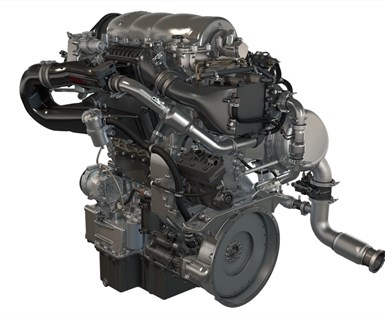Opposed-Piston Engine Developer Touts 2027 Diesel Emissions Capabilities
Achates moves closer to production, starting with commercial vehicles
“At a time when the industry is contemplating many technology options to address clean energy, it’s important to have pragmatic solutions in the conversation that can have more immediate impact, and meeting or beating the most stringent regulations with less cost and complexity and no reliance on enabling infrastructure is compelling,” asserts David Crompton, president and CEO of San Diego-based Achates Power.
The Engine

Achates 3-cylinder 10.6-liter diesel (Image: Achates)
In this case, the pragmatic solution Crompton is referring to is Achates’ opposed-piston engine, which promises to meet more stringent emissions requirements with current aftertreatment systems—and without having to switch to electrified drivetrains.
The Tests
Crompton is celebrating recent tests that showed Achates’ 3-cylinder 10.6-liter opposed-piston diesel engine complies with pending 2027 emissions requirements.
The Results
In the tests, which were conducted in San Diego and Detroit, the heavy-duty diesel mill measured:
- 0.02 grams per brake hp-hour of nitrogen oxide emissions, meeting 2027 California requirements that cut NOx levels by 90%
- 422 g of carbon dioxide, which is 8% below the current U.S. Environmental Protection Agency standard of 460 g CO2 and 2% under 2027 targets
Why It Matters
The results were achieved with a conventional exhaust fluid injection aftertreatment system, which Achates boasts is more efficient, cheaper and less complex than conventional engines and aftertreatment approaches.
What’s Next?
Achates has been developing the technology, which eliminates the cylinder head and valve train, since 2004. (Others have been at it since the 1930s.)
The tests results are another step in the validation and commercialization processes.
In addition to commercial vehicles, Achates is working on applications for passenger cars, military vehicles and stationary applications.
RELATED CONTENT
-
Choosing the Right Fasteners for Automotive
PennEngineering makes hundreds of different fasteners for the automotive industry with standard and custom products as well as automated assembly solutions. Discover how they’re used and how to select the right one. (Sponsored Content)
-
On Electric Pickups, Flying Taxis, and Auto Industry Transformation
Ford goes for vertical integration, DENSO and Honeywell take to the skies, how suppliers feel about their customers, how vehicle customers feel about shopping, and insights from a software exec
-
BMW Uses Fabric Skin Again
In 2008 BMW revealed a concept vehicle that was unusual in that the body panels weren’t made from steel, aluminum or composites but, rather, a fabric that was fitted over an underlying metal frame.










